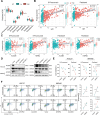Transcriptional profiling reveals H.pylori-associated genes induced inflammatory cell infiltration and chemoresistance in gastric cancer
- PMID: 40519938
- PMCID: PMC12162319
- DOI: 10.3389/fimmu.2025.1592558
Transcriptional profiling reveals H.pylori-associated genes induced inflammatory cell infiltration and chemoresistance in gastric cancer
Abstract
Background: H. pylori infection is closely associated with the tumor microenvironment (TME) in gastric cancer (GC), yet its underlying mechanism is elusive. Hence, it is imperative to explore the microenvironment and drug resistance arising from H. pylori to enhance therapeutic strategies for GC.
Methods: Employing transcriptional bioinformatics, we computed a H. pylori-associated prognostic index (HPI) using datasets from TCGA and GSE62254 containing ACSM5 and HSPB2 gene expression. We assessed IC50 values for anticancer drugs and immune cell infiltration to evaluate the therapeutics and TME based on the HPI. Further, we validated the transcriptional profiling findings by examining drug sensitivity transfected with siACSM5 and siHSPB2 and analyzing scRNA-seq data and clinical patient samples.
Results: ACSM5 and HSPB2 were identified as correlates of H. pylori infection in GC. Significantly, we established the H. pylori-associated prognostic index (HPI) and found that a high HPI was linked with a worse prognosis. Classification based on the HPI indicated an enhanced infiltration of tumor microenvironment cells and resistance to anti-tumor drugs.
Conclusion: The HPI, reflecting newly identified and complementary biomarkers, correlated with the TME and could accurately project chemoresistance and an altered immune cell distribution in GC patients, thus providing clinical guidance on therapeutic interventions.
Keywords: ACSM5; H. pylori; HspB2; eosinophils; gastric cancer; tumor microenvironment.
Copyright © 2025 Tan, Wu, Liu, Wang, Qin, Pan, Xiong, Ma, Zhao, Zhou, Liu, Lu, Zhuo and Hong.
Conflict of interest statement
The authors declare that the research was conducted in the absence of any commercial or financial relationships that could be construed as a potential conflict of interest.
Figures







Similar articles
-
NLRP3 inflammasome expression affects immune cell infiltration and clinical prognosis in Helicobacter pylori infection‑associated gastric cancer.Mol Med Rep. 2025 Jul;32(1):185. doi: 10.3892/mmr.2025.13550. Epub 2025 May 2. Mol Med Rep. 2025. PMID: 40314099 Free PMC article.
-
Identification of core immune-related genes CTSK, C3, and IFITM1 for diagnosing Helicobacter pylori infection-associated gastric cancer through transcriptomic analysis.Int J Biol Macromol. 2025 Jan;287:138645. doi: 10.1016/j.ijbiomac.2024.138645. Epub 2024 Dec 10. Int J Biol Macromol. 2025. PMID: 39667460
-
Helicobacter pylori is associated with less tumor-infiltrating lymphocytes and a poor prognosis in gastric cancer.BMC Gastroenterol. 2025 May 30;25(1):420. doi: 10.1186/s12876-025-04003-w. BMC Gastroenterol. 2025. PMID: 40448000 Free PMC article.
-
MicroRNAs in Helicobacter pylori-infected gastric cancer: Function and clinical application.Pharmacol Res. 2024 Jul;205:107216. doi: 10.1016/j.phrs.2024.107216. Epub 2024 May 16. Pharmacol Res. 2024. PMID: 38761883 Review.
-
Helicobacter pylori triggers inflammation and oncogenic transformation by perturbing the immune microenvironment.Biochim Biophys Acta Rev Cancer. 2024 Sep;1879(5):189139. doi: 10.1016/j.bbcan.2024.189139. Epub 2024 Jun 17. Biochim Biophys Acta Rev Cancer. 2024. PMID: 38897421 Review.
References
MeSH terms
Substances
LinkOut - more resources
Full Text Sources
Medical
Miscellaneous

